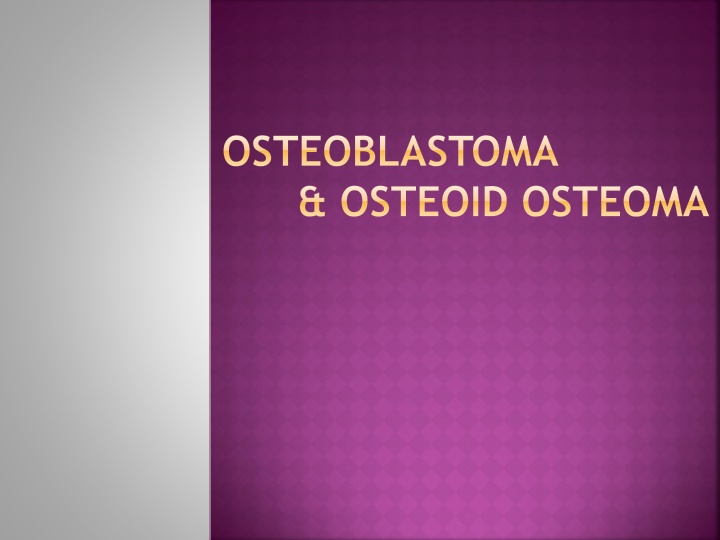
Osteoblastoma, Osteoid, and Osteoma: Clinical Features, Histopathology, Treatment, and More
Explore the clinical features, histopathology, treatment, and prognosis of osteoblastoma, osteoid, and osteoma, along with information on cementoblastoma and chondroma. Learn about the different aspects of these conditions, including rare occurrences, diagnostic characteristics, and treatment options.
Download Presentation

Please find below an Image/Link to download the presentation.
The content on the website is provided AS IS for your information and personal use only. It may not be sold, licensed, or shared on other websites without obtaining consent from the author. If you encounter any issues during the download, it is possible that the publisher has removed the file from their server.
You are allowed to download the files provided on this website for personal or commercial use, subject to the condition that they are used lawfully. All files are the property of their respective owners.
The content on the website is provided AS IS for your information and personal use only. It may not be sold, licensed, or shared on other websites without obtaining consent from the author.
E N D
Presentation Transcript
OSTEOBLASTOMA & OSTEOID OSTEOMA
CLINICAL FEATURES mandible, poeterior Female, <30 2-4 cm Osteoblastoma pain, tenderness, swelling Aspirin Well or ill radiolucency with patchy mineralization reactive sclerosis Aggressive osteoblastoma: larger, sever pain <2 cm pain, nocturnal osteoid osteoma Aspirin Well radiolucency Reactive sclerosis target
HISTOPATHOLOGY Mineralized material, reversal lines Osteoclast Osteoblast, hyperchromatic Loose connective tissue
TREATMENT & PROGNOSIS Local excision Good prognosis Uncommon recurrence Rare osteosarcoma Aggressive osteoblastoma:50% recurrence
CEMENTOBLASTOMA Odontogenic neoplasm of cementoblasts
CLINICAL FEATURES Rare Mandible, molar & premolar(50% 6) Children & young adults 2/3 pain , swelling Some: exp. , erosion, infiltration into the pulp Radiopaque mass with a thin radiolucent rim Obscured outline of the root
HISTOPATHOLOGY Resemble osteoblastoma Thick trabeculae of mineralized material with blast-like rim Basophilic reversal line Uncalcified matrix( radiolucent zone)
TREATMENT & PROGNOSIS Ext . Of the tooth with mass Root amputation
CHONDROMA Benign tumor of cartilage Hands and foot In the jaws: many recurred & acted in malignant manner Arise from vestigial cartilaginous: anterior maxilla, symphysis, coronoid, condyle
CLINICAL FEATURES 3rd, 4thdecade Condyle , anterior maxilla Painless, slow growing Radiolucency with central area of radiopacity Single Multiple: Ollier disease, Maffucci syndrome
HISTOPATHOLOGY circumscribed mass of mature cartilage well formed lacunae, small chondrocytes
TREATMENT & PROGNOSIS Should be Considered as potential chondrosarcoma Total surgical removal
DESMOPLASTIC FIBROMA Uncommon tumor of fibroblastic origin Soft tissue fibromatosis Tuberous sclerosis
CLINICAL FEATURES <30 years Mandible, Femur, pelvice bones Molar angle-ascending ramus Painless swelling Multi or unilocular radiolucent area Thin cortex Rare cortical reaction Soft tissue mass
HISTOPATHOLOGY Small elongated fibroblasts & collagen, tipical, no mitoses Bone spicules
TREATMENT & PROGNOSIS Benign Locally aggressive, bone destruction, soft tissue extension Radical surgery
OSTEOSARCOMA Definition Most common malignancy
CLINICAL FEATURES Paget & irradiation Extragnathic bimodal Jaw 3rd& 4th Male max = man * Swelling & pain
RADIOGRAPHY Ill defined Spiking Sunburst Codman s triangle Widening of PDL
HISTOPATHOLOGY Microscopic criteria Common Types Low grade well dif
TREATMENT & PROGNOSIS jaws: less aggressive, low grade Most important indicator Metastase lung & brain Man, Max Usual cause of death
JUXTACORTICAL OSTEOSARCOMA
Parosteal pedanculated no elevation & reaction Low grade Inadequate surgery ? sessile Periosteal extend to the soft tissue chondroblastic treatment prognosis
POSTIRRADIATION BONE SARCOMA 3-14 years after radiation Dose Osteosarcoma, fibrosarcoma, chondrosarcoma prognosis
